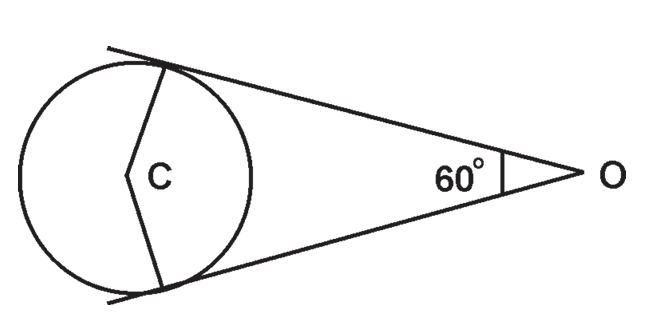
GRE Prep Club Daily Prep
Thank you for using the timer - this advanced tool can estimate your performance and suggest more practice questions. We have subscribed you to Daily Prep Questions via email.
Customized
for You
Track
Your Progress
Practice
Pays
Not interested in getting valuable practice questions and articles delivered to your email? No problem, unsubscribe here.
In the figure below, the two tangents to the circle having centre at
[#permalink]
 16 Jan 2025, 04:08
16 Jan 2025, 04:08
Expert Reply
Question Stats:
 100% (02:16) correct
100% (02:16) correct
 0% (00:00) wrong
0% (00:00) wrong  based on 5 sessions
based on 5 sessions
Hide Show timer Statistics
In the figure below, the two tangents to the circle having centre at the point C, meet at the point O. What is the area of the circle if the length of the tangents from the point O to the circle is 3 inches?

GRE geometry question circle.png [ 34.18 KiB | Viewed 579 times ]
(A) $\(\pi\)$
(B) $\(2 \pi\)$
(C) $\(3 \pi\)$
(D) $\(4 \pi\)$
(E) $\(5 \pi\)$
Attachment:
GRE geometry question circle.png [ 34.18 KiB | Viewed 579 times ]
(A) $\(\pi\)$
(B) $\(2 \pi\)$
(C) $\(3 \pi\)$
(D) $\(4 \pi\)$
(E) $\(5 \pi\)$
- Part of the project: GRE Quant & Verbal ADVANCED Daily Challenge 2024 Edition - Gain 20 Kudos & Get FREE Access to GRE Prep Club TESTS
- Also replying to the unanswered questions
In the figure below, the two tangents to the circle having centre at
[#permalink]
 23 Feb 2025, 01:39
23 Feb 2025, 01:39
Expert Reply
We are given that two tangents $\(\mathrm{OA} \& \mathrm{OB}\)$, of length 3 inches each, intersect at point O and form an angle of 60 degrees (Two tangents meeting at a common point outside the circle are equal in length).
As triangle $\(\mathrm{AOC} \&\)$ triangle CBO are congruent triangles, we get angle $\(\mathrm{AOC}=\)$ angle $\(\mathrm{COB}=30\)$ degrees each. Also as radius is always perpendicular on tangent, we get angle $\mathrm{CAO}=90$ degree .
Now, using the measure of angle CAO ( $\(=90\)$ degree) \& angle AOC ( $\(=30\)$ degrees), in triangle ACO , we get angle $\(\mathrm{ACO}=180^{\circ}-\left(90^{\circ}+30^{\circ}\right)=180^{\circ}-120^{\circ}=60^{\circ}\)$
As shown in the figure to the right, in a triangle having angles $\(90,60 \& 30\)$, the corresponding opposite sides are $\(2 \mathrm{a}, \mathrm{a} \sqrt{3} \& \mathrm{a}\)$ respectively.

GRE triangle (6).png [ 44.61 KiB | Viewed 446 times ]
Using the $\(90,60,30\)$ triangle rule, in the triangle ACO , the side opposite to 60 degrees i.e. CO is given as 3 , so we get the side opposite to 30 degrees as $\(\frac{3}{\sqrt{3}}=\sqrt{3}=\mathrm{AO}=\)$ radius of the circle.
So, we get the area of the circle as $\(\pi r^2=\pi(\sqrt{3})^2=3 \pi\)$
Hence the answer is (C).
As triangle $\(\mathrm{AOC} \&\)$ triangle CBO are congruent triangles, we get angle $\(\mathrm{AOC}=\)$ angle $\(\mathrm{COB}=30\)$ degrees each. Also as radius is always perpendicular on tangent, we get angle $\mathrm{CAO}=90$ degree .
Now, using the measure of angle CAO ( $\(=90\)$ degree) \& angle AOC ( $\(=30\)$ degrees), in triangle ACO , we get angle $\(\mathrm{ACO}=180^{\circ}-\left(90^{\circ}+30^{\circ}\right)=180^{\circ}-120^{\circ}=60^{\circ}\)$
As shown in the figure to the right, in a triangle having angles $\(90,60 \& 30\)$, the corresponding opposite sides are $\(2 \mathrm{a}, \mathrm{a} \sqrt{3} \& \mathrm{a}\)$ respectively.
Attachment:
GRE triangle (6).png [ 44.61 KiB | Viewed 446 times ]
Using the $\(90,60,30\)$ triangle rule, in the triangle ACO , the side opposite to 60 degrees i.e. CO is given as 3 , so we get the side opposite to 30 degrees as $\(\frac{3}{\sqrt{3}}=\sqrt{3}=\mathrm{AO}=\)$ radius of the circle.
So, we get the area of the circle as $\(\pi r^2=\pi(\sqrt{3})^2=3 \pi\)$
Hence the answer is (C).

gmatclubot
In the figure below, the two tangents to the circle having centre at [#permalink]
23 Feb 2025, 01:39
Moderators:


